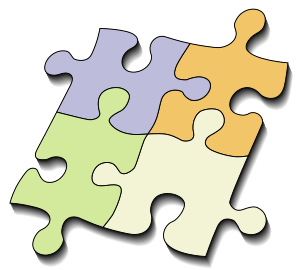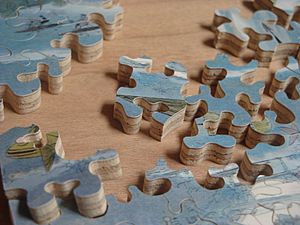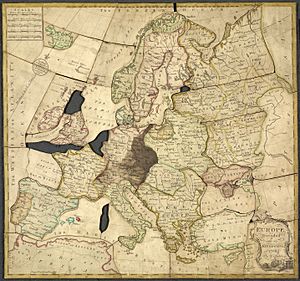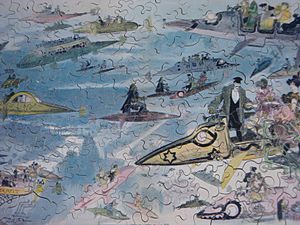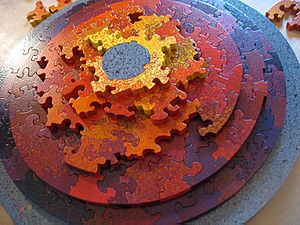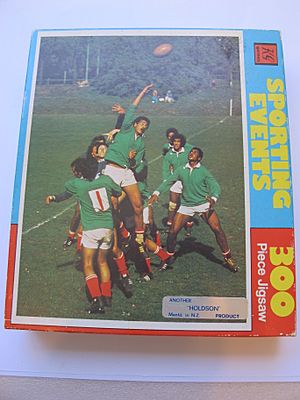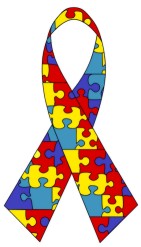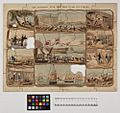Jigsaw puzzle facts for kids
A jigsaw puzzle is a fun tiling puzzle where you put together many oddly shaped, interlocking pieces. Each piece usually has a small part of a picture on it. When all the pieces fit together, they create a complete picture! Some puzzles are even more advanced, like round ones or those that show optical illusions.
Jigsaw puzzles were first made by painting a picture on a flat piece of wood. Then, the picture was cut into small pieces using a special saw called a jigsaw. That's where the name "jigsaw puzzle" comes from! John Spilsbury, a mapmaker and engraver from London, is known for selling the first jigsaw puzzles around 1760. Today, most jigsaw puzzles are made from cardboard.
You can find all sorts of pictures on jigsaw puzzles. Many show scenes from nature, buildings, or cool patterns. Castles and mountains are classic choices. But really, any picture can become a puzzle! Some companies can even turn your own photos into a puzzle. Once you finish a puzzle, you can glue it onto a backing and hang it up like artwork.
In recent years, many helpful tools have been made for puzzle fans. These include special boards, cases, frames, and roll-up mats to make puzzling easier.
Contents
The History of Jigsaw Puzzles
The first jigsaw puzzle was likely made around 1760 by John Spilsbury, an engraver and mapmaker from London. He used a special saw to cut maps that were glued onto sheets of hardwood. He cut along the borders of countries, making a puzzle that was great for teaching geography. These early puzzles were called "dissections."
The name "jigsaw" became popular around 1880. This was when fretsaws became the main tool for cutting the puzzle shapes. Cardboard jigsaw puzzles started appearing in the late 1800s. However, it took a while for them to replace wooden puzzles. Manufacturers thought people might see cardboard puzzles as lower quality.
Jigsaw puzzles became super popular during the Great Depression. They were a cheap, fun, and reusable way to entertain people for a long time. Around this time, puzzles also became more complex and interesting for adults. Companies even gave them away in product promotions and used them in advertising. Customers would complete a puzzle to see an image of the product being advertised.
Did you know that doing jigsaw puzzles can be good for your brain? The Alzheimer Society of Canada says that puzzles are one of many activities that can help keep your brain active. This might even help reduce the risk of developing Alzheimer's disease later in life.
Different Kinds of Jigsaw Puzzles
Jigsaw puzzles come in many different sizes. Smaller puzzles often have 300, 500, or 750 pieces. More common puzzles for adults can have 1,000, 1,500, 2,000, or even up to 40,000 pieces!
There are also smaller jigsaw puzzles made just for children. These are usually rated by how many pieces they have. For very young kids, puzzles with as few as 4 to 9 large pieces are common. These pieces are big enough so they are not a choking hazard. They are often made of wood or plastic, which makes them strong and easy to clean.
Some puzzles are made to be double-sided. This means you can solve them from either side! This makes them harder because you have to make sure you're looking at the correct side of each piece.
"Family puzzles" are special. They usually have 100–550 pieces, but the pieces come in three different sizes: large, medium, and small. The pieces are often arranged so the larger ones are on one side and the smaller ones are towards the middle. This allows family members of different ages and skill levels to work on the puzzle together at the same time.
There are also three-dimensional jigsaw puzzles. Many of these are made of wood or styrofoam. You often have to solve them in a specific order, because some pieces won't fit if others are already in place. Another type is puzzle boxes. These are simple 3D jigsaw puzzles that have a small drawer or box inside for storage.
Another type of 3D puzzle is a puzzle globe. Like a flat puzzle, a globe puzzle is often made of plastic. But when you put the pieces together, they form a three-dimensional shape, like a ball. Most globe puzzles look like spherical shapes such as the Earth, the Moon, or old maps of the Earth.
You can also find computer versions of jigsaw puzzles. These are great because you don't have to clean up, and you can't lose any pieces! Many computer puzzles don't let you rotate the pieces, so they are already in the correct direction. This makes them much easier than a real puzzle with the same number of pieces.

Some online puzzle websites let you choose your own puzzle size, how the pieces are cut, and what image to use. You can even upload your own pictures to turn into puzzles! For example, you can find an online jigsaw puzzle of Trolleholm Castle in Sweden and time yourself to see how fast you can finish it. The New Yorker Magazine website also has jigsaw puzzles made from their magazine covers. These puzzles are timed and offer different difficulty levels.
Jigsaw puzzles can cost different amounts depending on how complex they are, how many pieces they have, and the brand. Puzzles for kids can be as cheap as $5.00, while larger puzzles might be closer to $50.00. The most expensive puzzle ever sold went for $27,000 in 2005 at a charity auction!
Some word puzzle games use pieces that look like jigsaw puzzle pieces. A few examples include Alfa-Lek, Jigsaw Words, and Word Jigsaw.
Largest Jigsaw Puzzles Ever Made
Here are some of the largest commercially available jigsaw puzzles by pieces and title:
- 48,000 pieces: Around the World
- 42,000 pieces: La vuelta al Mundo
- 40,320 pieces: Memorable Disney Moments
- 33,600 pieces: Wild Life
- 32,256 pieces: New York City Window
- 32,256 pieces: Double Retrospect
- 24,000 pieces: Life, The greatest puzzle
- 20,000 pieces: Weltkarte
Amazing World Records for Jigsaw Puzzles
As of January 2018, the biggest commercially available jigsaw puzzle was made by Grafika. It has 48,000 pieces and shows 208 famous places and landmarks painted by Adrian Chesterman.
In 2016, the German company Ravensburger released their largest puzzle. It shows 10 scenes from Disney movies and has 40,320 pieces. When put together, it measures about 680 centimeters by 192 centimeters!
The largest jigsaw puzzle ever made in terms of size covered an area of about 58,435 square feet! It had 21,600 pieces, and each piece was very large, measuring 50 centimeters by 50 centimeters. This giant puzzle was put together on November 3, 2002, by 777 people at the old Kai Tak Airport in Hong Kong.
The jigsaw puzzle with the most pieces ever had 551,232 pieces! It measured 14.85 meters by 23.20 meters (about 48 feet 8 inches by 76 feet 1 inch). Students from the University of Economics, Ho Chi Minh City put it together on September 24, 2011, at the Phú Thọ Indoor Stadium in Ho Chi Minh City, Vietnam.
Jigsaw Puzzles as Symbols
Have you ever noticed the Wikipedia logo? It's a globe made out of jigsaw pieces! The globe isn't complete, and some pieces are missing. This symbolizes that there's always room to add new knowledge to Wikipedia.
Jigsaw puzzle pieces were first used as a symbol for autism in 1963. The United Kingdom's National Autistic Society chose jigsaw pieces for their logo. They felt it showed the "puzzling" nature of autism and how people with autism might feel like they don't "fit in" due to social differences. Also, jigsaw pieces were easy to recognize and weren't used by other groups. Since then, puzzle pieces have been used in the logos and materials of many organizations, including the Autism Society of America and Autism Speaks.
Images for kids
See also
 In Spanish: Rompecabezas para niños
In Spanish: Rompecabezas para niños


